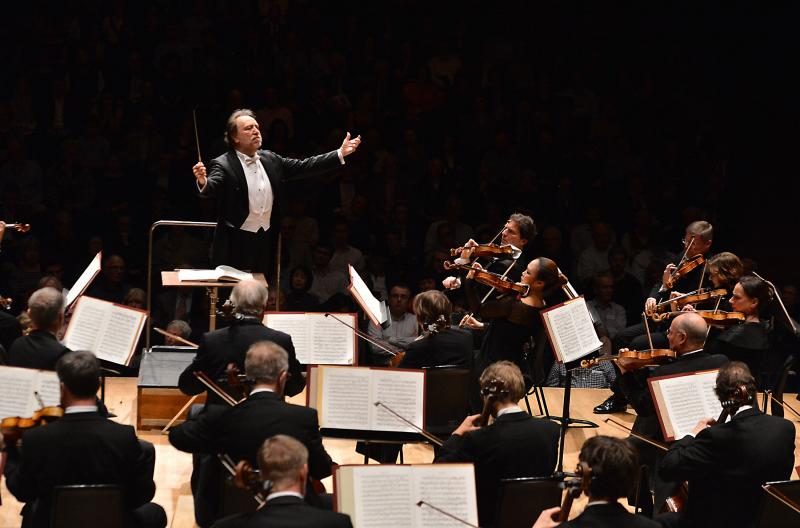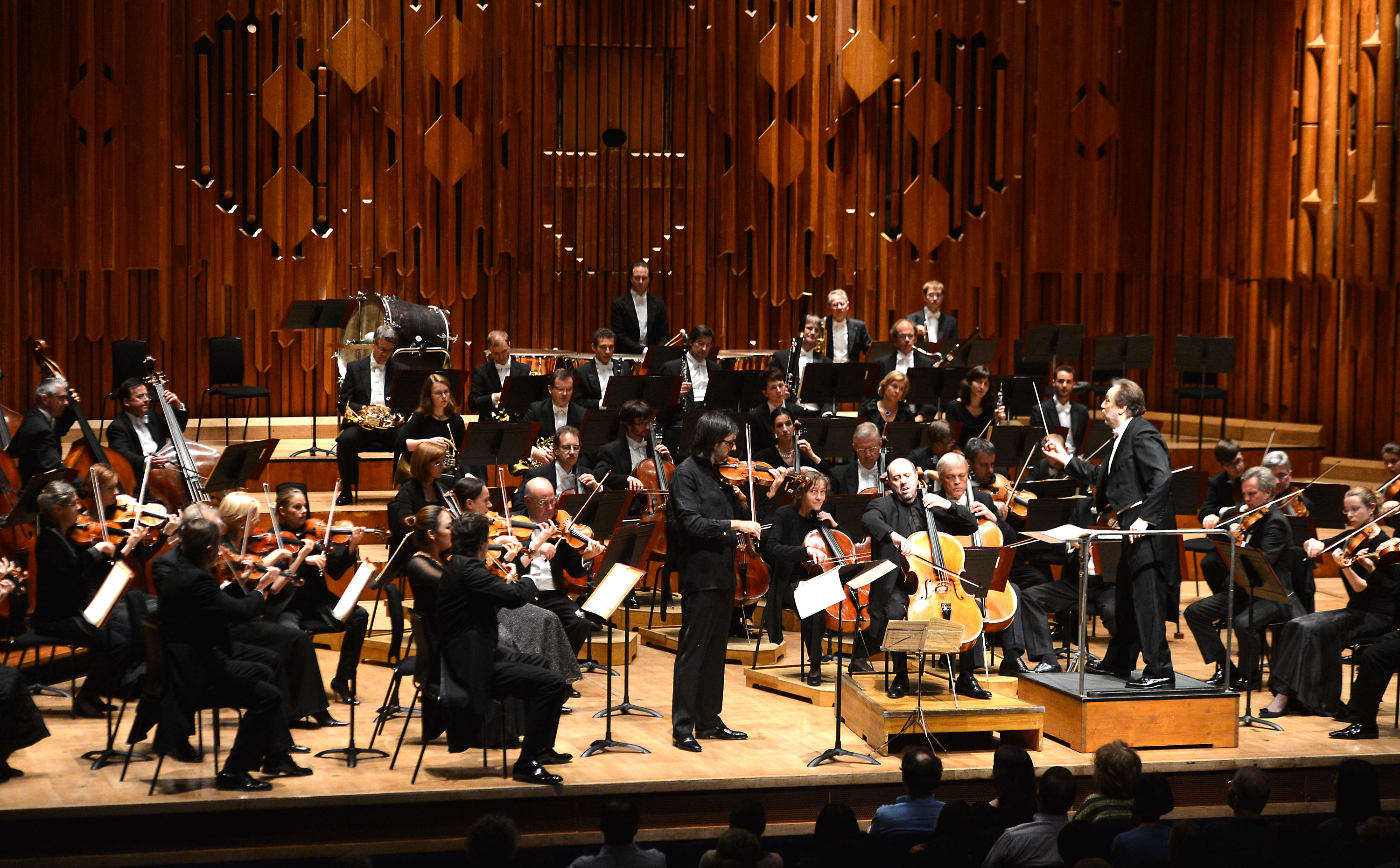Brahms Cycle 1: Kavakos, Dindo, Leipzig Gewandhaus Orchestra, Chailly, Barbican | reviews, news & interviews
Brahms Cycle 1: Kavakos, Dindo, Leipzig Gewandhaus Orchestra, Chailly, Barbican
Brahms Cycle 1: Kavakos, Dindo, Leipzig Gewandhaus Orchestra, Chailly, Barbican
Rebellious Brahms from the team which knows him best

For the Leipzig Gewandhaus Orchestra’s second residency at the Barbican Centre Riccardo Chailly pulled focus on an entirely new sounding Brahms. Gone were all those bad performance practices, bad habits, from the early 20th century, gone was the lingering romanticism, the willful soupiness, and in with a vengeance came a classical rigour, a lean and hungry vitality.
Chailly is neatly lining up the four symphonies with the four concertos - and first up were Leonidas Kavakos and Enrico Dindo (pictured with Chailly and the orchestra below) in the Double Concerto. The opening statement from the orchestra was a throwing down of the gauntlet if ever I heard one: emphatic, arresting, cut to the bone. Cellist Enrico Dindo then soliloquised in Shakesperian fashion, a whole range of colours suggesting a whole range of emotions, all within a couple of minutes. Kavakos’ violin parried but the drama, gruff and gritty as it was, was in the conversation, now conciliatory, now confrontational. The telepathy, chemistry, call it what you will, between Kavakos and Dindo was self-evident and challenging and even that prayerful slow movement tune refused to linger. Mellow it was not.

And so to the first of the symphonies - 14 years in the making - sounding like it was determined to make up for lost time. That lowering opening coming up through the bass lines, timpani carving a path through the mire, violins reaching for light, was as arresting as it’s ever been, an imperative alla breve. That was to be Chailly’s defining way throughout the piece with the allegro of this opening movement determined to shake off disillusionment. It smouldered.
The deep and abiding consolation of the slow movement with the deep echo of string basses beautifully realised brought gorgeous singing oboe playing and radiant work from the Leipzig concert master. How different this movement sounded with a century of soupy sentiment stripped away.
The finale had a surprise or two up its sleeve, the desolate pizzicato of the opening paragraph falling like rain from the gathering clouds. I’ve never heard it in quite the same way before. And how good to hear the burnished horn solo and ensuing chorale freed of portentousness. Chailly managed the switch from the big “ode to joy” theme into Brahms’ impulsive allegro with a exhilarating upping of the tempo and when he and Brahms finally broke free in the coda the momentary disbelief at the reckless abandon of the tempo thrillingly demonstrated jut how conditioned we had become. Bring on the rest.
rating
Explore topics
Share this article
The future of Arts Journalism
You can stop theartsdesk.com closing!
We urgently need financing to survive. Our fundraising drive has thus far raised £49,000 but we need to reach £100,000 or we will be forced to close. Please contribute here: https://gofund.me/c3f6033d
And if you can forward this information to anyone who might assist, we’d be grateful.

Subscribe to theartsdesk.com
Thank you for continuing to read our work on theartsdesk.com. For unlimited access to every article in its entirety, including our archive of more than 15,000 pieces, we're asking for £5 per month or £40 per year. We feel it's a very good deal, and hope you do too.
To take a subscription now simply click here.
And if you're looking for that extra gift for a friend or family member, why not treat them to a theartsdesk.com gift subscription?
more Classical music
 Hallé John Adams festival, Bridgewater Hall / RNCM, Manchester review - standing ovations for today's music
From 1980 to 2025 with the West Coast’s pied piper and his eager following
Hallé John Adams festival, Bridgewater Hall / RNCM, Manchester review - standing ovations for today's music
From 1980 to 2025 with the West Coast’s pied piper and his eager following
 Kaploukhii, Greenwich Chamber Orchestra, Cutts, St James's Piccadilly review - promising young pianist
A robust and assertive Beethoven concerto suggests a player to follow
Kaploukhii, Greenwich Chamber Orchestra, Cutts, St James's Piccadilly review - promising young pianist
A robust and assertive Beethoven concerto suggests a player to follow
 Robin Holloway: Music's Odyssey review - lessons in composition
Broad and idiosyncratic survey of classical music is insightful but slightly indigestible
Robin Holloway: Music's Odyssey review - lessons in composition
Broad and idiosyncratic survey of classical music is insightful but slightly indigestible
 Classical CDs: Wolf-pelts, clowns and social realism
British ballet scores, 19th century cello works and contemporary piano etudes
Classical CDs: Wolf-pelts, clowns and social realism
British ballet scores, 19th century cello works and contemporary piano etudes
 Bizet in 150th anniversary year: rich and rare French offerings from Palazzetto Bru Zane
Specialists in French romantic music unveil a treasure trove both live and on disc
Bizet in 150th anniversary year: rich and rare French offerings from Palazzetto Bru Zane
Specialists in French romantic music unveil a treasure trove both live and on disc
 Scottish Chamber Orchestra, Ibragimova, Queen’s Hall, Edinburgh review - rarities, novelties and drumrolls
A pity the SCO didn't pick a better showcase for a shining guest artist
Scottish Chamber Orchestra, Ibragimova, Queen’s Hall, Edinburgh review - rarities, novelties and drumrolls
A pity the SCO didn't pick a better showcase for a shining guest artist
 Kilsby, Parkes, Sinfonia of London, Wilson, Barbican review - string things zing and sing in expert hands
British masterpieces for strings plus other-worldly tenor and horn - and a muscular rarity
Kilsby, Parkes, Sinfonia of London, Wilson, Barbican review - string things zing and sing in expert hands
British masterpieces for strings plus other-worldly tenor and horn - and a muscular rarity
 From Historical to Hip-Hop, Classically Black Music Festival, Kings Place review - a cluster of impressive stars for the future
From quasi-Mozartian elegance to the gritty humour of a kitchen inspection
From Historical to Hip-Hop, Classically Black Music Festival, Kings Place review - a cluster of impressive stars for the future
From quasi-Mozartian elegance to the gritty humour of a kitchen inspection
 Shibe, LSO, Adès, Barbican review - gaudy and glorious new music alongside serene Sibelius
Adès’s passion makes persuasive case for the music he loves, both new and old
Shibe, LSO, Adès, Barbican review - gaudy and glorious new music alongside serene Sibelius
Adès’s passion makes persuasive case for the music he loves, both new and old
 Anja Mittermüller, Richard Fu, Wigmore Hall review - a glorious hall debut
The Austrian mezzo shines - at the age of 22
Anja Mittermüller, Richard Fu, Wigmore Hall review - a glorious hall debut
The Austrian mezzo shines - at the age of 22
 First Person: clarinettist Oliver Pashley on the new horizons of The Hermes Experiment's latest album
Compositions by members of this unusual quartet feature for the first time
First Person: clarinettist Oliver Pashley on the new horizons of The Hermes Experiment's latest album
Compositions by members of this unusual quartet feature for the first time

Add comment